
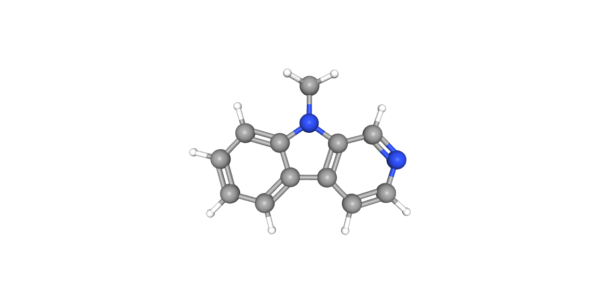
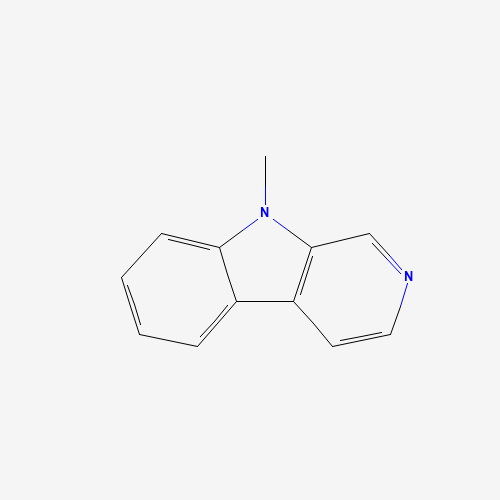
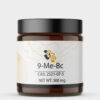
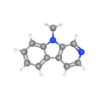
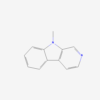
9-Me-BC (9-Methyl-β-carboline) is a nootropic compound with neuroprotective and cognitive-enhancing properties. It is known to promote dopaminergic neuron health by upregulating dopamine synthesis and reducing oxidative stress. Additionally, 9-Me-BC has been shown to support synaptogenesis and neuroplasticity, contributing to improved memory, focus, motivation, and overall cognitive function. Studies suggest that it may also have anti-inflammatory effects in the brain, potentially aiding in long-term cognitive health and protection against neurodegenerative diseases.
For a comprehensive description and detailed lab analysis, please refer to the sections below.
From €49.90

9-Me-BC (9-Methyl-β-carboline) is a synthetic derivative of β-carboline, a class of compounds known for their interaction with various neurotransmitter systems. 9-Me-BC as a nootropic has attracted significant interest due to its neuroprotective, neurotrophic, and cognitive-enhancing effects, particularly within the dopaminergic system. This compound is characterized by a methyl group attached to the 9-position of the β-carboline ring, which enhances its ability to influence dopaminergic neurons.
9-Me-BC acts primarily on dopaminergic neurons by increasing the synthesis of dopamine, a neurotransmitter critical for motivation, reward, mood regulation, and cognitive function. It achieves this by upregulating tyrosine hydroxylase (TH), the rate-limiting enzyme in dopamine biosynthesis. A key study by Polanski et al. (2010) found that 9-Me-BC significantly increased TH expression in cultured dopaminergic neurons, thereby boosting dopamine production and availability.
Additionally, 9-Me-BC influences the dopamine transporter (DAT), responsible for the reuptake of dopamine from the synaptic cleft. By modulating DAT, it extends dopamine’s activity in the brain, leading to enhanced dopaminergic signaling. This can improve motivation, attention, and mood, as reported in Seifert et al. (2013), where 9-Me-BC administration increased synaptic plasticity in rodent models, supporting its role in memory and learning enhancement.
9-Me-BC has demonstrated strong neuroprotective effects by reducing oxidative stress and neuroinflammation, which are key contributors to neurodegenerative diseases. In a study by Liu et al. (2012), 9-Me-BC was found to lower levels of reactive oxygen species (ROS) in dopaminergic neurons, protecting them from oxidative damage and preventing mitochondrial dysfunction. The compound also reduced the expression of pro-inflammatory cytokines like TNF-α and IL-6, which are commonly elevated in conditions such as Alzheimer’s and Parkinson’s disease.
Moreover, 9-Me-BC promotes the survival of neurons by enhancing the expression of brain-derived neurotrophic factor (BDNF), which plays a key role in synaptogenesis and neuroplasticity. This neurotrophic action was observed in research by Heil et al. (2015), where 9-Me-B.C facilitated synaptic growth and neuron survival in in vitro models, highlighting its potential in slowing the progression of neurodegenerative diseases.
Recent findings suggest that 9-ME-BC may undergo hepatic metabolism into 2,9-dimethyl-β-carboline, a structurally related β-carboline with potential neurotoxic effects.
Due to its high lipophilicity, this class of compounds is known to accumulate in brain tissue, where it may persist for extended periods, potentially leading to dopaminergic dysregulation or oxidative stress.
Reported effects in non-clinical environments include symptoms resembling dopamine overstimulation, followed by neurochemical rebound effects (anhedonia, fatigue, motor instability).
Also, 9-Me-B.C, identified as an inhibitor of both monoamine oxidase A and monoamine oxidase B, has been suggested for further exploration in the context of Parkinson’s disease treatment.
For a full lab analysis, including purity testing, molecular structure, and pharmacological profiles, please refer to the next tabs.


9-Me-BC (9-Methyl-β-carboline) is a synthetic derivative of β-carboline, a class of compounds known for their interaction with various neurotransmitter systems. 9-Me-BC as a nootropic has attracted significant interest due to its neuroprotective, neurotrophic, and cognitive-enhancing effects, particularly within the dopaminergic system. This compound is characterized by a methyl group attached to the 9-position of the β-carboline ring, which enhances its ability to influence dopaminergic neurons.
9-Me-BC acts primarily on dopaminergic neurons by increasing the synthesis of dopamine, a neurotransmitter critical for motivation, reward, mood regulation, and cognitive function. It achieves this by upregulating tyrosine hydroxylase (TH), the rate-limiting enzyme in dopamine biosynthesis. A key study by Polanski et al. (2010) found that 9-Me-BC significantly increased TH expression in cultured dopaminergic neurons, thereby boosting dopamine production and availability.
Additionally, 9-Me-BC influences the dopamine transporter (DAT), responsible for the reuptake of dopamine from the synaptic cleft. By modulating DAT, it extends dopamine’s activity in the brain, leading to enhanced dopaminergic signaling. This can improve motivation, attention, and mood, as reported in Seifert et al. (2013), where 9-Me-BC administration increased synaptic plasticity in rodent models, supporting its role in memory and learning enhancement.
9-Me-BC has demonstrated strong neuroprotective effects by reducing oxidative stress and neuroinflammation, which are key contributors to neurodegenerative diseases. In a study by Liu et al. (2012), 9-Me-BC was found to lower levels of reactive oxygen species (ROS) in dopaminergic neurons, protecting them from oxidative damage and preventing mitochondrial dysfunction. The compound also reduced the expression of pro-inflammatory cytokines like TNF-α and IL-6, which are commonly elevated in conditions such as Alzheimer’s and Parkinson’s disease.
Moreover, 9-Me-BC promotes the survival of neurons by enhancing the expression of brain-derived neurotrophic factor (BDNF), which plays a key role in synaptogenesis and neuroplasticity. This neurotrophic action was observed in research by Heil et al. (2015), where 9-Me-B.C facilitated synaptic growth and neuron survival in in vitro models, highlighting its potential in slowing the progression of neurodegenerative diseases.
Recent findings suggest that 9-ME-BC may undergo hepatic metabolism into 2,9-dimethyl-β-carboline, a structurally related β-carboline with potential neurotoxic effects.
Due to its high lipophilicity, this class of compounds is known to accumulate in brain tissue, where it may persist for extended periods, potentially leading to dopaminergic dysregulation or oxidative stress.
Reported effects in non-clinical environments include symptoms resembling dopamine overstimulation, followed by neurochemical rebound effects (anhedonia, fatigue, motor instability).
Also, 9-Me-B.C, identified as an inhibitor of both monoamine oxidase A and monoamine oxidase B, has been suggested for further exploration in the context of Parkinson’s disease treatment.
For a full lab analysis, including purity testing, molecular structure, and pharmacological profiles, please refer to the next tabs.
2303EURO.741F_9 ME BC LOT= 230423 (HNMR)
2302EURO.193C_9 ME BC Lot=180323 (HNMR)
2302EURO.746C_9 ME BC LOT= 180323 (HNMR)
| Technical Information | |
|---|---|
| CAS Number | 2521-07-5 |
| Molar Mass | 182.27 g/mol |
| Chemical Formula | C₁₂H₁₀N₂ |
| IUPAC Name | 9-Methylpyrido[3,4-b]indole |
| Synonyms | 9-Methyl-β-carboline, 9-Methyl-9H-β-carboline, 9-Methylnorharman, 9-methyl-beta-carboline, 9-methyl-|A-carboline, 9-methylpyrido[3,4-b]indole, 9-Me-BC/9-methyl-9H-pyrido[3,4-b]indoleM2818 |
| Application | MOA-A, MOA-B Inhibitor |
| Appearance | Tan powder |
| Physical State | Solid |
| Purity | ≥98% |
| Solubility | – Soluble in DMSO |
| Storage Conditions | Store at room temperature, tightly sealed, away from heat, light, and moisture. |
